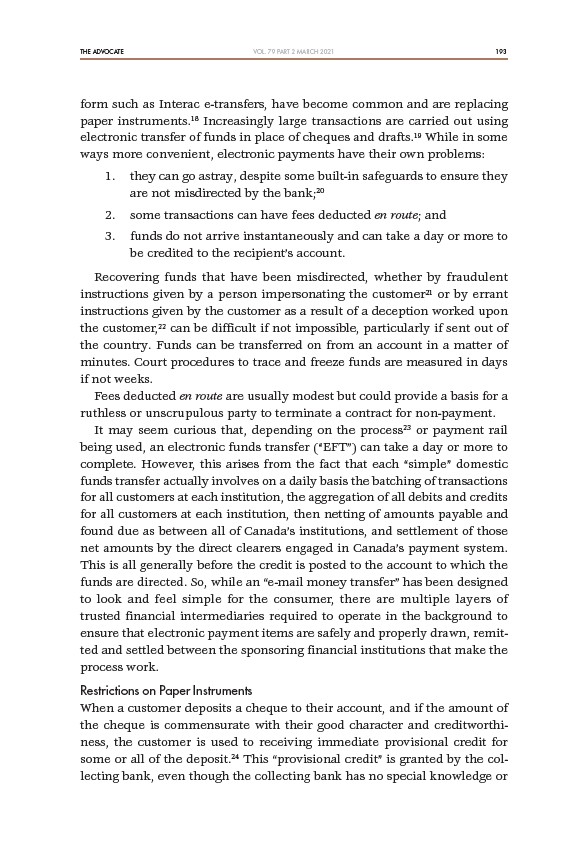
THE ADVOCATE 193
VOL. 79 PART 2 MARCH 2021
form such as Interac e-transfers, have become common and are replacing
paper instruments.18 Increasingly large transactions are carried out using
electronic transfer of funds in place of cheques and drafts.19 While in some
ways more convenient, electronic payments have their own problems:
1. they can go astray, despite some built-in safeguards to ensure they
are not misdirected by the bank;20
2. some transactions can have fees deducted en route; and
3. funds do not arrive instantaneously and can take a day or more to
be credited to the recipient’s account.
Recovering funds that have been misdirected, whether by fraudulent
instructions given by a person impersonating the customer21 or by errant
instructions given by the customer as a result of a deception worked upon
the customer,22 can be difficult if not impossible, particularly if sent out of
the country. Funds can be transferred on from an account in a matter of
minutes. Court procedures to trace and freeze funds are measured in days
if not weeks.
Fees deducted en route are usually modest but could provide a basis for a
ruthless or unscrupulous party to terminate a contract for non-payment.
It may seem curious that, depending on the process23 or payment rail
being used, an electronic funds transfer (“EFT”) can take a day or more to
complete. However, this arises from the fact that each “simple” domestic
funds transfer actually involves on a daily basis the batching of transactions
for all customers at each institution, the aggregation of all debits and credits
for all customers at each institution, then netting of amounts payable and
found due as between all of Canada’s institutions, and settlement of those
net amounts by the direct clearers engaged in Canada’s payment system.
This is all generally before the credit is posted to the account to which the
funds are directed. So, while an “e-mail money transfer” has been designed
to look and feel simple for the consumer, there are multiple layers of
trusted financial intermediaries required to operate in the background to
ensure that electronic payment items are safely and properly drawn, remitted
and settled between the sponsoring financial institutions that make the
process work.
Restrictions on Paper Instruments
When a customer deposits a cheque to their account, and if the amount of
the cheque is commensurate with their good character and creditworthiness,
the customer is used to receiving immediate provisional credit for
some or all of the deposit.24 This “provisional credit” is granted by the collecting
bank, even though the collecting bank has no special knowledge or